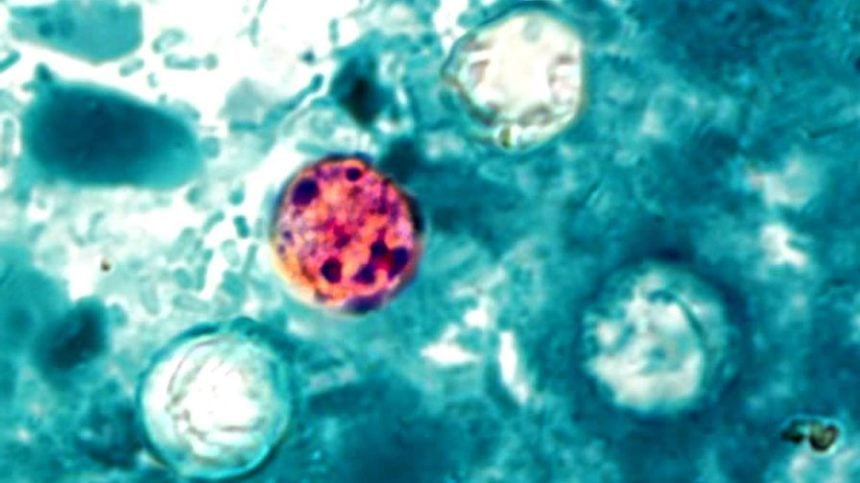Canada and US Investigate Mystery Outbreak of Cyclospora Illnesses

Copyright: DPDx – Melanie Moser, USCDCP
The Public Health Agency of Canada (PHAC) and the US Centers for Disease Control and Prevention (CDC) are conducting an investigation into an increase in “non-travel related Cyclospora illnesses” that has been spreading throughout the country.
PHAC announced that they are working with public health and food safety partners to figure out how the infections might be spreading in Canada.
Cyclosporiasis is an intestinal illness caused by the microscopic parasite Cyclospora cayetanensis, according to the CDC.
“Previous Cyclospora illnesses have been linked to various types of imported fresh produce, including pre-packaged salad mix, basil, cilantro, berries, lettuce, and snow and snap peas,” PHAC wrote on its website.
As of June 30, the agency reported a total of 84 cases of Cyclospora infections in the following provinces: British Columbia (1), Ontario (75), and Quebec (8).
Four people were hospitalized in Canada, but no deaths were reported, according to Food Poison Journal.
“To date, there is no recall or Public Health Notice, the investigation is ongoing,” the outlet added.
In the US, as of June 28, 2022, there were 61 confirmed cases. Six were hospitalized, with no deaths reported.
Thirteen states have reported cases so far.

More from Food Poison Journal:
Cyclosporiasis illnesses are reported year-round in the United States. However, during the spring and summer months there is often an increase in cyclosporiasis acquired in the United States (i.e., “domestically acquired”). The exact timing and duration of these seasonal increases in domestically acquired cyclosporiasis can vary, but reports tend to increase starting in May. In previous years the reported number of cases peaked between June and July, although activity can last as late as September. The overall health impact (e.g., number of infections or hospitalizations) and the number of identified clusters of cases (i.e., cases that can be linked to a common exposure) also vary from season to season. Previous U.S. outbreaks of cyclosporiasis have been linked to various types of fresh produce, including basil, cilantro, mesclun lettuce, raspberries, and snow peas.
CDC, along with state and federal health and regulatory officials, monitor cases of cyclosporiasis in the United States in the spring and summer months to detect outbreaks linked to a common food source. However, many cases of cyclosporiasis cannot be directly linked to an outbreak, in part because of the lack of validated laboratory “fingerprinting” methods needed to link cases of Cyclospora infection. Officials use questionnaires to interview sick people to determine what they ate in the 14-day period before illness onset. If a commonality is found, CDC and partners work quickly to determine if a contaminated food product is still available in stores or in peoples’ homes and issue advisories.
Here’s what we know about Cyclosporiasis:
What causes cyclosporiasis?
Cyclosporiasis is an illness of the intestines caused by a parasite called Cyclospora.How is cyclosporiasis spread?
The most common way that Cyclospora is spread is by eating food or drinking water that contains the Cyclospora parasite.Cyclospora is not common on food and is not in drinking water in Canada.
However, food can be a source of cyclosporiasis for Canadians when imported from countries where Cyclospora is common. Foods imported to Canada that have been linked to the Cyclospora parasite include:
- basil
- cilantro
- raspberries
- blackberries
- mesclun lettuce
- snow and snap peas
- pre-packaged salad mix
Cyclosporiasis is unlikely to spread directly between people because the parasite can only infect others once it leaves the body through feces. To be able to spread, the parasite needs to be outside the body for about 7 to 15 days.
Only humans, and possibly primates, can be affected by Cyclospora. Therefore, cyclosporiasis does not spread between humans and animals.
If you have already had cyclosporiasis, you can get it after recovery if you are exposed to the parasite again.
Where is it found?
Cyclospora can be found in sewage and untreated water. It is found worldwide, but is most commonly found in tropical and subtropical areas, such as:
- Peru
- Cuba
- India
- Nepal
- Mexico
- Guatemala
- Southeast Asia
- Dominican Republic
How does food and water become contaminated?
The Cyclospora parasite gets in sources of water when feces from infected people enter the water supply. Food can then become contaminated when this water is used:
- on crops
- in food processing and packaging
Foods can also become contaminated from infected farm workers or food handlers. This is when proper sanitation techniques are not used, such as:
- hand washing
- gloves or other barrier
- avoidance of cross-contamination
No comments